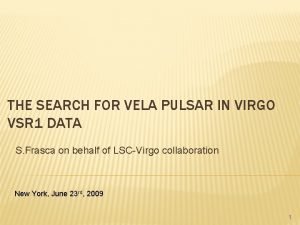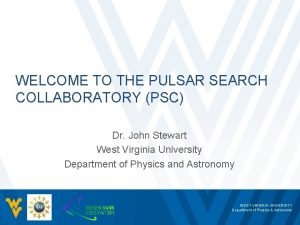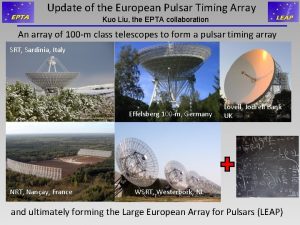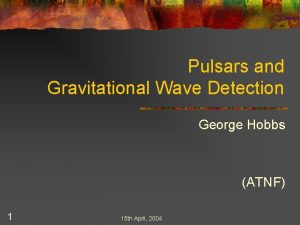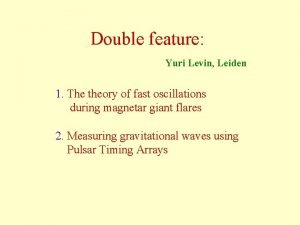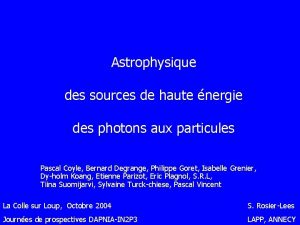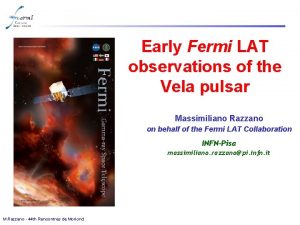First light from the Vela pulsar with the










- Slides: 10

First light from the Vela pulsar with the Fermi Gamma-ray Space Telescope Massimiliano Razzano (INFN-Pisa) on behalf of the Fermi LAT Collaboration Workshop Sci. Ne. GHE 08 (Abano Terme, Oct. 9 2008) M. Razzano

Fermi Gamma-ray Space Telescope International space mission devoted to the study of the High-Energy gamma rays from the Universe Successfully launched on June 11, 2008 from Cape Canaveral Air Force Station; 26 Aug NASA renamed GLAST to Fermi in honour of Prof. Enrico Fermi (1901 -1954) “At last, GLAST” (Titled by the Astronomy Picture of the day June 13 2008)

Fermi Key Features Two GLAST instruments: Compared to EGRET: • > 100 Me. V, 1 yr sensitivity x 25 • localization x 102 • field of view x 5 • observing efficiency x 2 • deadtime x 10 -3 Large Area Telescope (LAT) LAT: high energy (20 Me. V 300 Ge. V) GBM: low energy (8 ke. V 30 Me. V) Spacecraft Partner: General Dynamics GLAST Burst Monitor (GBM) The LAT Huge field of view LAT: 20% of the sky at any instant; in sky survey mode, expose all parts of sky for ~30 minutes every 3 hours. GBM: whole unocculted sky at any time. Huge energy range, including largely unexplored band 10 Ge. V - 100 Ge. V Large leap in all key capabilities, transforming our knowledge of the gamma-ray Universe. Great discovery potential (for more info see Wed. talks about Fermi).

First Light Sky. Map – 95 hrs Equivalent to EGRET’s first year!

ID of Vela pulsar Radio pulsation discovered in 1968 in the Vela SNR, bright pulsar: S 1. 4 Ghz~1. 5 Jy Located RA=08: 35: 20. 61, dec=-45: 10: 34. 87 (almost on the Galactic plane @b~-2. 8˚) D~287+19 -17 pc (VLBI parallax in 2003) P: ~89 ms; Pdot ~3 x 10 -13 s/s Young pulsar tc~11 kyr Energetic Edot~7 x 1036 erg/s Bsurf ~3. 4 x 1012 G 7 high confidence gamma-ray pulsars Low confidence gamma-ray pulsars (D. Thompson, 2003)

Vela pulsar seen by EGRET Gamma-ray emission discovered by SAS-2 (Thompson et al. 1975) Further observed by COS-B (Bennett et al. 1977) and EGRET (e. g. Kanbach et al. 1994). Recent observations made by AGILE (Pellizzoni et al. 2008, in press) EGRET Vela spectrum (Kanbach et al. 1994) Vela >5 Ge. V (black) emission compared with >100 Me. V (yellow) (Thompson 2003) Vela lightcurve (E>100 Me. V) ~8000 ph (Kanbach et al. 1994

Vela and Fermi Vela is the brightest persistent source in the gamma-ray sky; Ideal target for first observations and instrument tuning & calibration; Primary source (together with Crab and Geminga) for timing validation; During Launch&Early Orbit (L&EO) Operations Vela was targeted for pointed observations; First light: Region 240º<l<300º, -20º<b<20º (22 x slower than actual Vela rotation);

Vela first light Lightcurve E>100 Me. V, ROI radius=3˚; Data between June 30 and July 11 2008 (First light survey + additional survey observations); Ephemerides provided by Parkes observatory (radio pulse superimposed);

The Vela pulsar movie E<300 Me. V (red) 300 Me. V<E<1 Ge. V(Green) E>1 Ge. V (blue)

Conclusions During first light Vela was clearly seen by Fermi-LAT together with other EGRET pulsars; In few days LAT collected a number of photons comparable to EGRET; After timing check and validations, Vela lightcurve has been built and is in agreement with EGRET within statistics (pulse components, peak positions, separation); Vela pulsar was studied during Launch&Early Orbit (L&EO) operations by LAT scientists for better characterizing and calibrating the instrument (e. g. PSF, IRFs, systematics); Start with new science! After EGRET there are unanswered key questions about Vela and pulsar physics: What is the detailed lightcurve structure with respect to other energies? What are the regions where the gamma-ray emission takes place? What is the spectrum of the lightcurve component? Is the Vela PWN emitting gamma-rays? In order to answer some of these questions, we are studying with the higher statistics and resolution of the LAT the Vela pulsar…coming soon!
